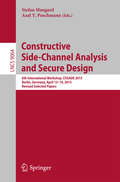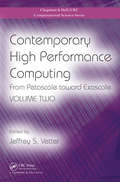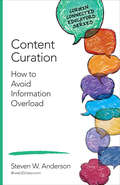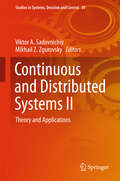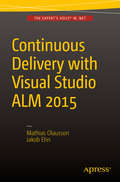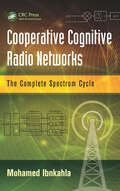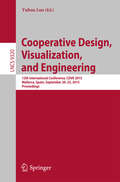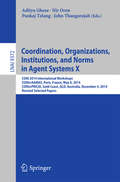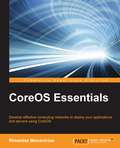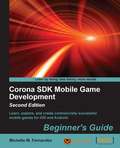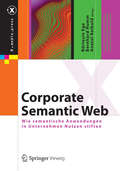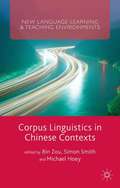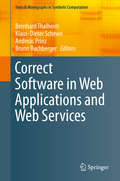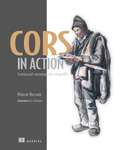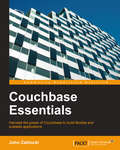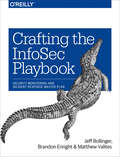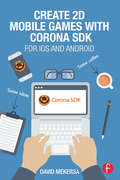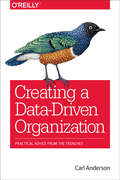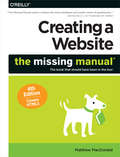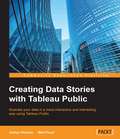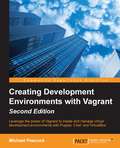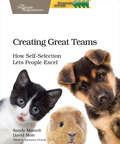- Table View
- List View
Constructive Side-Channel Analysis and Secure Design: 6th International Workshop, COSADE 2015, Berlin, Germany, April 13-14, 2015. Revised Selected Papers (Lecture Notes in Computer Science #9064)
by Stefan Mangard Axel Y. PoschmannThis book constitutes the thoroughly refereed post-conference proceedings of the 6th International Workshop, COSADE 2015, held in Berlin, Germany, in April 2015. The 17 revised full papers presented were carefully selected from 48 submissions. the focus of this workshop was on following topics: side-channel attacks, FPGA countermeasures, timing attacks and countermeasures, fault attacks, countermeasures, and Hands-on Side-channel analysis.
The Contemporary Family in France
by Arnaud Régnier-LoilierThis book provides a portrait of the family in France today, revealing many of the deep-seated, demographic changes that have affected French society in recent decades. It first focuses on conjugal and family trajectories, examining union formation, types of union, entry into parenthood, influence of religion, and separation. Next, the book explores domestic organization within the couple. It looks at gender differences in attitudes to task-sharing, division of household and parenting tasks, influence of past partnership history, and changes after a birth. The book presents a series of studies based on the French version of the international Generations and Gender Survey, a major comparative research project conducted in 20 countries to collect information from individuals aged 18-79 about relationships and processes in the life course. Inside, readers will find insightful analysis of the survey results by sociologists, demographers, and economists, and come to better understand recent demographic and social developments in France as well as the factors influencing them. The book will appeal to a broad audience of students and researchers interested in family, gender, and intergenerational relations. In addition, as the survey data are comparable across countries, the book will provide researchers with ideas for further research opportunities in Europe and beyond.
Contemporary High Performance Computing: From Petascale toward Exascale, Volume Two (Chapman And Hall/crc Computational Science Ser.)
by Jeffrey S. VetterHPC is used to solve a number of complex questions in computational and data-intensive sciences. These questions include the simulation and modeling of physical phenomena, such as climate change, energy production, drug design, global security, and materials design; the analysis of large data sets such as those in genome sequencing, astronomical observation, and cybersecurity; and the intricate design of engineered products, such as airplanes and automobiles.This second volume of Contemporary High Performance Computing: From Petascale toward Exascale continues to document international HPC ecosystems, including the sponsors and sites that host them. Each chapter is punctuated with a site's flagship system and:Presents highlights of applications, workloads, and benchmarksDescribes hardware architectures, system software, and programming systemsExplores storage, visualization, and analyticsExamines the data center/facility as well as system statisticsFeaturing pictures of buildings and systems in production, floorplans, and many block diagrams and charts to illustrate system design and performance, Contemporary High Performance Computing: From Petascale toward Exascale, Volume Two delivers a detailed snapshot of the rich history of practice in modern HPC. This book provides a valuable reference for researchers in HPC and computational science.
Content Curation: How to Avoid Information Overload (Corwin Connected Educators Series)
by Steven W. AndersonSavvy internet consumption starts right here! Teachers and students are constantly inundated with information, yet lack the organizational skill necessary to effectively utilize it. From Twitter hashtags to online communities, this handy guide will help you to find, store, and share the best information and resources found on the web today—and teach your students to do the same. Real-world tips, tools, in-depth examples and lesson plans help you systematically: Understand the curation process Find, collect, and share reliable web-based information Build students’ information literacy skills Help students research and organize problem-based learning projects Use cutting-edge curation tools like Evernote, Diigo, and Pocket The Corwin Connected Educators series is your key to unlocking the greatest resource available to all educators: other educators. Being a Connected Educator is more than a set of actions: it’s a belief in the potential of technology to fuel lifelong learning. "Speaking from his own experience and perspectives as a learner, teacher, and educational leader, Steven Anderson brings clarity to a process that can be difficult and overwhelming. Steven offers tried and tested strategies and tools for evaluating, organizing, and sharing the vast amount of online content educators and students have at their fingertips. If you′re drowning in digital content, this book is your life jacket. " —Jayme Linton, Assistant Professor of Education Lenoir-Rhyne University, Hickory, NC
Content Curation: How to Avoid Information Overload (Corwin Connected Educators Series)
by Steven W. AndersonSavvy internet consumption starts right here! Teachers and students are constantly inundated with information, yet lack the organizational skill necessary to effectively utilize it. From Twitter hashtags to online communities, this handy guide will help you to find, store, and share the best information and resources found on the web today—and teach your students to do the same. Real-world tips, tools, in-depth examples and lesson plans help you systematically: Understand the curation process Find, collect, and share reliable web-based information Build students’ information literacy skills Help students research and organize problem-based learning projects Use cutting-edge curation tools like Evernote, Diigo, and Pocket The Corwin Connected Educators series is your key to unlocking the greatest resource available to all educators: other educators. Being a Connected Educator is more than a set of actions: it’s a belief in the potential of technology to fuel lifelong learning. "Speaking from his own experience and perspectives as a learner, teacher, and educational leader, Steven Anderson brings clarity to a process that can be difficult and overwhelming. Steven offers tried and tested strategies and tools for evaluating, organizing, and sharing the vast amount of online content educators and students have at their fingertips. If you′re drowning in digital content, this book is your life jacket. " —Jayme Linton, Assistant Professor of Education Lenoir-Rhyne University, Hickory, NC
Continuous and Distributed Systems II: Theory and Applications (Studies in Systems, Decision and Control #30)
by Mikhail Z. Zgurovsky Viktor A. SadovnichiyAs in the previous volume on the topic, the authors close the gap between abstract mathematical approaches, such as applied methods of modern algebra and analysis, fundamental and computational mechanics, nonautonomous and stochastic dynamical systems, on the one hand, and practical applications in nonlinear mechanics, optimization, decision making theory and control theory on the other. Readers will also benefit from the presentation of modern mathematical modeling methods for the numerical solution of complicated engineering problems in biochemistry, geophysics, biology and climatology. This compilation will be of interest to mathematicians and engineers working at the interface of these field. It presents selected works of the joint seminar series of Lomonosov Moscow State University and the Institute for Applied System Analysis at National Technical University of Ukraine "Kyiv Polytechnic Institute". The authors come from Brazil, Germany, France, Mexico, Spain, Poland, Russia, Ukraine, and the USA.
Continuous Delivery with Visual Studio ALM 2015
by Jakob Ehn Mathias OlaussonThis book is the authoritative source on implementing Continuous Delivery practices using Microsoft's Visual Studio and TFS 2015. Microsoft MVP authors Mathias Olausson and Jakob Ehn translate the theory behind this methodology and show step by step how to implement Continuous Delivery in a real world environment. Building good software is challenging. Building high-quality software on a tight schedule can be close to impossible. Continuous Delivery is an agile and iterative technique that enables developers to deliver solid, working software in every iteration. Continuous delivery practices help IT organizations reduce risk and potentially become as nimble, agile, and innovative as startups. What you'll learn What Continuous Delivery is and how to use it to create better software more efficiently using Visual Studio 2015 How to use Team Foundation Server 2015 and Visual Studio Online to plan, design and implement powerful and reliable deployment pipelines Detailed step by step instructions for implementing Continuous Delivery on a real project Who this book is for Developers, Release Engineers, Architects, Product Managers Table of Contents 1. Introduction to Continuous Delivery 2. Overview of Visual Studio ALM 2015 3. Designing an application for Continuous Delivery 4. Managing the Release Process 5. Source Control Management 6. PowerShell for Deployment 7. Build Automation 8. Managing Code Quality 9. Continuous Testing 10. Building a deployment pipeline 11. Measure and learn
Cooperative Cognitive Radio Networks: The Complete Spectrum Cycle
by Mohamed IbnkahlaCooperative Cognitive Radio Networks: The Complete Spectrum Cycle provides a solid understanding of the foundations of cognitive radio technology, from spectrum sensing, access, and handoff to routing, trading, and security. Written in a tutorial style with several illustrative examples, this comprehensive book: Gives an overview of cognitive radio systems and explains the different components of the spectrum cycle Features step-by-step analyses of the different algorithms and systems, supported by extensive computer simulations, figures, tables, and references Fulfills the need for a single source of information on all aspects of the spectrum cycle, including the physical, link, medium access, network, and application layers Offering a unifying view of the various approaches and methodologies, Cooperative Cognitive Radio Networks: The Complete Spectrum Cycle presents the state of the art of cognitive radio technology, addressing all phases of the spectrum access cycle.
Cooperative Design, Visualization, and Engineering: 12th International Conference, CDVE 2015, Mallorca, Spain, September 20-23, 2015. Proceedings (Lecture Notes in Computer Science #9320)
by Yuhua LuoThis book constitutes the refereed proceedings of the 12th International Conference on Cooperative Design, Visualization, and Engineering, CDVE 2015, held in Mallorca, Spain, in September 2015. The 30 full papers presented together with 4 short papers were carefully reviewed and selected from numerous submissions. There is a group of papers dressing the big data related to the cooperative work. It includes the information modeling, intensive task management, how to use the cloud technology to foster the cooperation etc. To deal with the social network issues is the topic of another group of papers in this volume. They range from creating programming languages to automate cooperative processes, social network information visualization, and the ranking cooperative research teams by analyzing the social network data.
Coordination, Organizations, Institutions, and Norms in Agent Systems X: COIN 2014 International Workshops, COIN@AAMAS, Paris, France, May 6, 2014, COIN@PRICAI, Gold Coast, QLD, Australia, December 4, 2014, Revised Selected Papers (Lecture Notes in Computer Science #9372)
by Aditya Ghose Nir Oren Pankaj Telang John ThangarajahThis book constitutes the thoroughly refereed post-conference proceedings of the 10th International Workshops on Coordination, Organizations, Institutions and Norms in Agent Systems, COIN 2014. The workshops were co-located with AAMAS 2014, held in Paris, France, in May 2014, and with PRICAI 2014, held in Gold Coast, QLD, Australia, in December 2014. The 16 full papers were carefully reviewed and selected for inclusion in this volume. The papers cover a wide range of topics from work on formal aspects of normative and team based systems, to software engineering with organisational concepts, to applications of COIN based systems, and to philosophical issues surrounding socio-technical systems. They highlight not only the richness of existing work in the field, but also point out the challenges and exciting research that remains to be done in the area.
CoreOS Essentials
by Rimantas MoceviciusIf you are a system administrator with experience in network virtualization and want to develop computing networks for deploying applications and servers, then this is the book for you. Knowledge of Linux operating systems and Docker is expected.
Corona SDK Mobile Game Development: Beginner's Guide - Second Edition
by Michelle M. FernandezThis book is for anyone who wants to have a go at creating commercially successfully games for Android and iOS. You don't need game development or programming experience.
Corporate Semantic Web: Wie semantische Anwendungen in Unternehmen Nutzen stiften (X.media.press)
by Börteçin Ege Bernhard Humm Anatol ReiboldCorporate Semantic Web - hierbei geht es um semantische Anwendungen, deren Einsatz für Kunden und Mitarbeiter von Unternehmen konkret Nutzen stiftet. Die Autoren, namhafte Experten aus Industrie und Wissenschaft, berichten über ihre Erfahrungen bei der Entwicklung solcher Anwendungen. Sie gehen auf Software-Architektur, Methodik, Linked Open Data Sets, Lizenzfragen und Technologieauswahl ein und präsentieren auch eine Marktstudie. Vorgestellt werden Anwendungen für die Branchen Telekommunikation, Logistik, verarbeitende Industrie, Energie, Medizin, Tourismus, Bibliotheks- und Verlagswesen sowie Kultur. Der Leser erhält so einen umfassenden Überblick über die Einsatzbereiche des Semantic Web sowie konkrete Umsetzungshinweise für eigene Vorhaben.
Corpus Linguistics in Chinese Contexts (New Language Learning and Teaching Environments)
by Simon Smith Bin Zou Michael HoeyRapid advances in computing have enabled the integration of corpora into language teaching and learning, yet in China corpus methods have not yet been widely adopted. Corpus Linguistics in Chinese Contexts aims to advance the state of the art in the use of corpora in applied linguistics and contribute to the expertise in corpus use in China.
Correct Software in Web Applications and Web Services (Texts & Monographs in Symbolic Computation)
by Klaus-Dieter Schewe Bernhard Thalheim Andreas Prinz Bruno BuchbergerThe papers in this volume aim at obtaining a common understanding of the challenging research questions in web applications comprising web information systems, web services, and web interoperability; obtaining a common understanding of verification needs in web applications; achieving a common understanding of the available rigorous approaches to system development, and the cases in which they have succeeded; identifying how rigorous software engineering methods can be exploited to develop suitable web applications; and at developing a European-scale research agenda combining theory, methods and tools that would lead to suitable web applications with the potential to implement systems for computation in the public domain.
CORS in Action: Creating and consuming cross-origin APIs
by Monsur HossainSummaryCORS in Action introduces Cross-Origin Resource Sharing (CORS) from both the server and the client perspective. It starts with the basics: how to make CORS requests and how to implement CORS on the server. It then explores key details such as performance, debugging, and security. API authors will learn how CORS opens their APIs to a wider range of users. JavaScript developers will find valuable techniques for building rich web apps that can take advantage of APIs hosted anywhere. The techniques described in this book are especially applicable to mobile environments, where browsers are guaranteed to support CORS. Purchase of the print book includes a free eBook in PDF, Kindle, and ePub formats from Manning Publications. About the BookSuppose you need to share some JSON data with another application or service. If everything is hosted on one domain, it's a snap. But if the data is on another domain, the browser's "same-origin" policy stops you cold. CORS is a new web standard that enables safe cross-domain access without complex server-side code. Mastering CORS makes it possible for web and mobile applications to share data simply and securely. CORS in Action introduces CORS from both the server and the client perspective. It starts with making and enabling CORS requests and then explores performance, debugging, and security. You'll learn to build apps that can take advantage of APIs hosted anywhere and how to write APIs that expand your products to a wider range of users. For web developers comfortable with JavaScript. No experience with CORS is assumed.What's InsideCORS from the ground upServing and consuming cross-domain dataBest practices for building CORS APIsWhen to use CORS alternatives like JSON-P and proxiesAbout the AuthorMonsur Hossain is an engineer at Google who has worked on API-related projects such as the Google JavaScript Client, the APIs Discovery Service, and CORS support for Google APIs.Table of ContentsPART 1 INTRODUCING CORSThe Core of CORSMaking CORS requestsPART 2 CORS ON THE SERVERHandling CORS requestsHandling preflight requestsCookies and response headersBest practicesPART 3 DEBUGGING CORS REQUESTSDebugging CORS requests APPENDIXESCORS referenceConfiguring your environmentWhat is CSRF?Other cross-origin techniques
Couchbase Essentials
by John ZablockiThis book is for those application developers who want to achieve greater flexibility and scalability from their software. Whether you are familiar with other NoSQL databases or have only used relational systems, this book will provide you with enough background to move you along at your own pace. If you are new to NoSQL document databases, the design discussions and introductory material will give you the information you need to get started with Couchbase.
Crafting the InfoSec Playbook
by Jeff Bollinger Brandon Enright Matthew ValitesAny good attacker will tell you that expensive security monitoring and prevention tools aren't enough to keep you secure. This practical book demonstrates a data-centric approach to distilling complex security monitoring, incident response, and threat analysis ideas into their most basic elements. You'll learn how to develop your own threat intelligence and incident detection strategy, rather than depend on security tools alone.Written by members of Cisco's Computer Security Incident Response Team, this book shows IT and information security professionals how to create an InfoSec playbook by developing strategy, technique, and architecture.Learn incident response fundamentals--and the importance of getting back to basicsUnderstand threats you face and what you should be protectingCollect, mine, organize, and analyze as many relevant data sources as possibleBuild your own playbook of repeatable methods for security monitoring and responseLearn how to put your plan into action and keep it running smoothlySelect the right monitoring and detection tools for your environmentDevelop queries to help you sort through data and create valuable reportsKnow what actions to take during the incident response phase
Create 2D Mobile Games with Corona SDK: For iOS and Android
by David MekersaCorona SDK is one of the most powerful tools used to create games and apps for mobile devices. The market requires speed; new developers need to operate quickly and efficiently. Create 2D Mobile Games with Corona SDK gives you the tools needed to master Corona - even within the framework of professional constraints. A must-read guide, this book gives you fast, accurate tips to learn the programming language necessary to create games. Read it sequentially or as an FAQ and you will have the tools you need to create any base game before moving on to advanced topics. The tutorial-based format: Contains step-by-step directions complete with coding and screenshots Is filled with tutorials, tips, and links to useful online resources Includes a comprehensive companion website featuring online exercise files to practice coding, full build samples from the text, additional book details, and more!
Creating a Data-Driven Organization
by Carl AndersonWhat do you need to become a data-driven organization? Far more than having big data or a crack team of unicorn data scientists, it requires establishing an effective, deeply-ingrained data culture. This practical book shows you how true data-drivenness involves processes that require genuine buy-in across your company, from analysts and management to the C-Suite and the board.Through interviews and examples from data scientists and analytics leaders in a variety of industries, author Carl Anderson explains the analytics value chain you need to adopt when building predictive business models--from data collection and analysis to the insights and leadership that drive concrete actions. You'll learn what works and what doesn't, and why creating a data-driven culture throughout your organization is essential.Start from the bottom up: learn how to collect the right data the right wayHire analysts with the right skills, and organize them into teamsExamine statistical and visualization tools, and fact-based story-telling methodsCollect and analyze data while respecting privacy and ethicsUnderstand how analysts and their managers can help spur a data-driven cultureLearn the importance of data leadership and C-level positions such as chief data officer and chief analytics officer
Creating a Data-Driven Organization: Practical Advice from the Trenches
by Carl AndersonWhat do you need to become a data-driven organization? Far more than having big data or a crack team of unicorn data scientists, it requires establishing an effective, deeply-ingrained data culture. This practical book shows you how true data-drivenness involves processes that require genuine buy-in across your company, from analysts and management to the C-Suite and the board.Through interviews and examples from data scientists and analytics leaders in a variety of industries, author Carl Anderson explains the analytics value chain you need to adopt when building predictive business models—from data collection and analysis to the insights and leadership that drive concrete actions. You’ll learn what works and what doesn’t, and why creating a data-driven culture throughout your organization is essential.Start from the bottom up: learn how to collect the right data the right wayHire analysts with the right skills, and organize them into teamsExamine statistical and visualization tools, and fact-based story-telling methodsCollect and analyze data while respecting privacy and ethicsUnderstand how analysts and their managers can help spur a data-driven cultureLearn the importance of data leadership and C-level positions such as chief data officer and chief analytics officer
Creating a Website: The Missing Manual
by Matthew MacdonaldYou can easily create a professional-looking website with nothing more than an ordinary computer and some raw ambition. Want to build a blog, sell products, create forums, or promote an event? No problem! This friendly, jargon-free book gives you the techniques, tools, and advice you need to build a site and get it up on the Web.The important stuff you need to know:Master the basics. Learn HTML5, the language of the Web.Design good-looking pages. Use styles to build polished layouts.Get it online. Find a reliable web host and pick a good web address.Use time-saving tools. Learn free tools for creating web pages and tracking your visitors.Attract visitors. Make sure people can find your site through popular search engines like Google.Build a community. Encourage repeat visits with social media.Bring in the cash. Host Google ads, sell Amazon's wares, or push your own products that people can buy via PayPal.Add pizzazz. Include audio, video, interactive menus, and a pinch of JavaScript.
Creating Data Stories with Tableau Public
by Matt Floyd Ashley OhmannThis book is targeted at investigative journalists and bloggers with an interest in making rich and interactive data visualizations. Intermediate Tableau Public users and organizations can also use this book as a reference guide and teaching aid. Members of the media team, such as data specialists, web developers, editors, producers, and managers can also benefit from an understanding of the structure and challenges of writing an interactive and interesting data visualization using Tableau Public.
Creating Development Environments with Vagrant - Second Edition
by Michael PeacockIf you are a developer who wants to have your development environment accurately reflect your live servers to tackle the ever-increasing complexity of web and software projects, this book is most certainly intended for you! It's assumed that you know the basics of Linux systems in the context of web-based projects.
Creating Great Teams: How Self-Selection Lets People Excel
by Sandy Mamoli David MolePeople are happiest and most productive if they can choose what they work on and who they work with. Self-selecting teams give people that choice. Build well-designed and efficient teams to get the most out of your organization, with step-by-step instructions on how to set up teams quickly and efficiently. You'll create a process that works for you, whether you need to form teams from scratch, improve the design of existing teams, or are on the verge of a big team re-shuffle. Discover how New Zealand's biggest e-commerce company completely restructured their business through Self-Selection. In the process, find out how to create high-performing groups by letting people self-organize into small, cross-functional teams. Step-by-step guides, easy-to-follow diagrams, practical examples, checklists, and tools will enable you to run a Self-Selection process within your organization.If you're a manager who wants to structure your organization into small teams, you'll discover why Self-Selection is the fastest and safest way to do so. You'll prepare for and organize a Self-Selection event and make sure your Self-Selection participants and fellow managers are on board and ready. If you're a team member, you'll discover what it feels like to be part of a Self-Selection process and what the consequences are for your daily work. You'll learn how to influence your colleagues and bosses to be open to the idea of Self-Selection. You'll provide your manager with a plan for how to facilitate a Self-Selection event, and with evidence that the system works.If you're feeling the pain and chaos of adding new people to your organization, or just want to ensure that your teams have the right people with the right skills, Self-Selection will help you create the effective teams you need.
